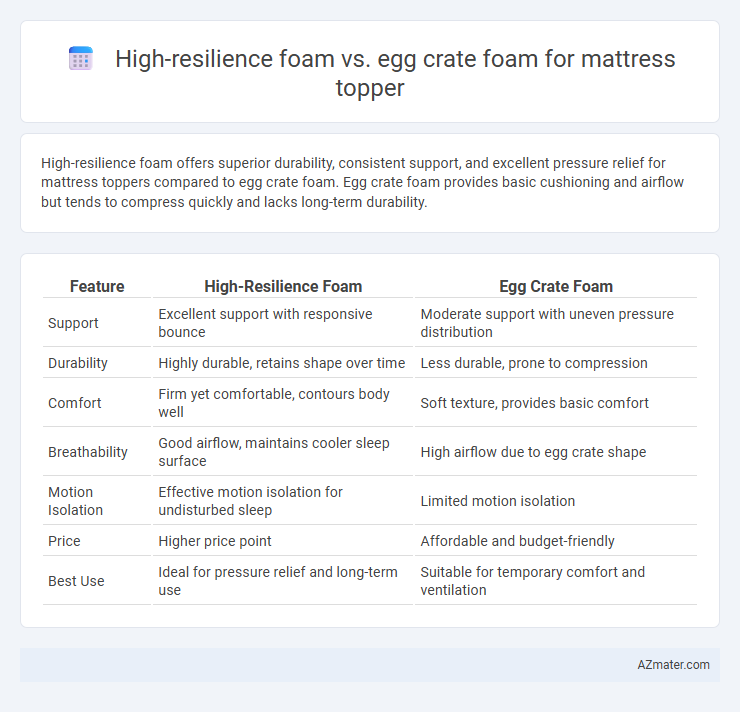High-resilience foam offers superior durability, consistent support, and excellent pressure relief for mattress toppers compared to egg crate foam. Egg crate foam provides basic cushioning and airflow but tends to compress quickly and lacks long-term durability.
Table of Comparison
| Feature | High-Resilience Foam | Egg Crate Foam |
|---|---|---|
| Support | Excellent support with responsive bounce | Moderate support with uneven pressure distribution |
| Durability | Highly durable, retains shape over time | Less durable, prone to compression |
| Comfort | Firm yet comfortable, contours body well | Soft texture, provides basic comfort |
| Breathability | Good airflow, maintains cooler sleep surface | High airflow due to egg crate shape |
| Motion Isolation | Effective motion isolation for undisturbed sleep | Limited motion isolation |
| Price | Higher price point | Affordable and budget-friendly |
| Best Use | Ideal for pressure relief and long-term use | Suitable for temporary comfort and ventilation |
Introduction to Mattress Topper Materials
High-resilience foam offers superior durability and support, maintaining its shape and providing consistent pressure relief for mattress toppers. Egg crate foam features a contoured surface that enhances airflow and breathability, promoting cooler sleep by reducing heat retention. Both materials improve comfort but differ significantly in longevity and firmness, influencing the overall sleeping experience.
What is High-Resilience Foam?
High-resilience foam is a type of polyurethane foam known for its excellent elasticity, durability, and supportive qualities, making it ideal for mattress toppers. It features a higher density and faster response to pressure compared to egg crate foam, providing enhanced comfort and spinal alignment. Unlike egg crate foam, high-resilience foam maintains its shape over time and offers superior breathability and pressure relief.
Understanding Egg Crate Foam
Egg crate foam, characterized by its contoured peaks and valleys, enhances airflow and reduces pressure points, making it a budget-friendly option for mattress toppers. Its open-cell structure promotes ventilation and heat dissipation, improving sleep comfort compared to flat foam layers. Compared to high-resilience foam, egg crate foam typically provides softer support and less durability but excels in cushioning and breathability.
Durability: High-Resilience Foam vs Egg Crate Foam
High-resilience foam offers superior durability compared to egg crate foam due to its dense, supportive structure that maintains shape and performance over extended use. Egg crate foam, while providing initial comfort and airflow, tends to compress and degrade faster under regular pressure, leading to reduced lifespan. Choosing high-resilience foam as a mattress topper ensures longer-lasting support and resistance to wear, making it a more cost-effective option in the long term.
Comfort and Support Comparison
High-resilience foam offers superior support and durability due to its high density and responsive properties, providing consistent pressure relief and alignment for various sleep positions. Egg crate foam enhances airflow and provides moderate cushioning by distributing body weight across its convoluted surface, which can improve comfort but may lack the support needed for long-term spinal alignment. Choosing between high-resilience and egg crate foam mattress toppers depends on the balance of desired firmness and breathability for optimal sleep quality.
Pressure Relief: Which Foam Performs Better?
High-resilience foam offers superior pressure relief by contouring closely to the body and providing consistent support, which helps alleviate pressure points more effectively than egg crate foam. Egg crate foam improves airflow and offers moderate pressure distribution but lacks the advanced responsiveness and durability that high-resilience foam delivers. For enhanced comfort and long-term pressure relief in mattress toppers, high-resilience foam consistently outperforms egg crate foam.
Breathability and Temperature Regulation
High-resilience foam offers superior breathability and temperature regulation due to its open-cell structure, allowing better airflow and moisture dissipation compared to egg crate foam. Egg crate foam, while providing pressure relief with its textured surface, often traps heat and retains moisture because of its denser material makeup. Choosing a mattress topper with high-resilience foam enhances cooler sleep environments by promoting air circulation and reducing heat buildup.
Cost Analysis: Value for Money
High-resilience foam offers superior durability and consistent support, often resulting in a higher initial cost but greater long-term value compared to egg crate foam. Egg crate foam is generally less expensive upfront, making it attractive for budget-conscious buyers, but it may compress faster and lose support over time, reducing overall cost-effectiveness. Evaluating mattress topper effectiveness alongside price, high-resilience foam provides better value for money through extended lifespan and enhanced comfort.
Best Uses for Each Foam Type
High-resilience foam excels in providing durable, responsive support and is ideal for sleepers seeking pressure relief and spinal alignment, often recommended for combination sleepers and those with back pain. Egg crate foam offers enhanced airflow and cushioning by contouring to the body's shape, making it best for improving mattress ventilation and alleviating surface pressure for side sleepers. Both foam types serve distinct purposes: high-resilience foam supports structural comfort while egg crate foam enhances breathability and softer pressure distribution.
Conclusion: Choosing the Right Mattress Topper
High-resilience foam offers superior support and durability, making it ideal for individuals needing long-lasting pressure relief and spinal alignment. Egg crate foam provides ventilation and light cushioning, suitable for those seeking enhanced airflow and a softer sleep surface. Selecting the right mattress topper depends on personal comfort preferences and specific sleep needs, with high-resilience foam better for support and egg crate foam favored for breathability.

Infographic: High-resilience foam vs Egg crate foam for Mattress topper
 azmater.com
azmater.com